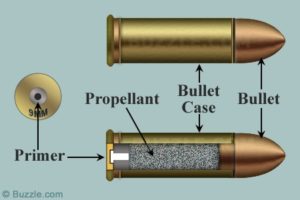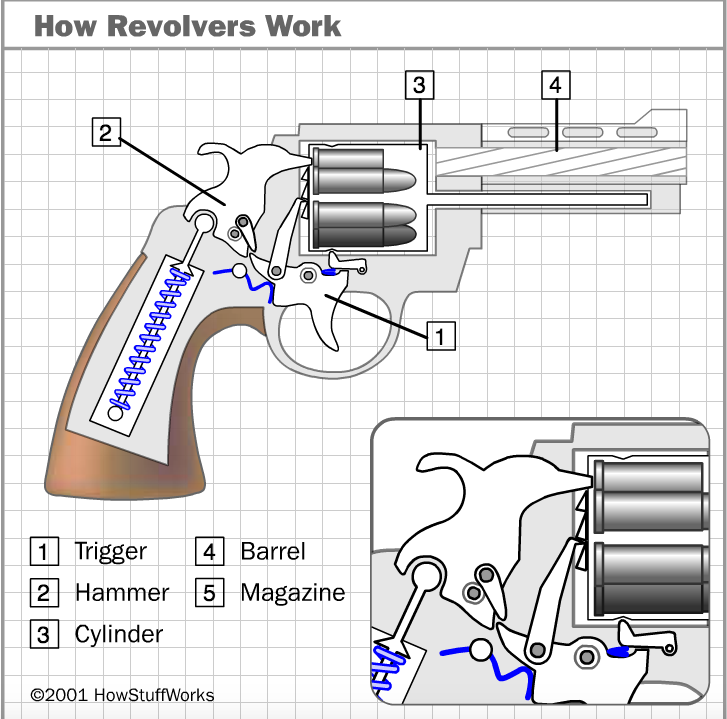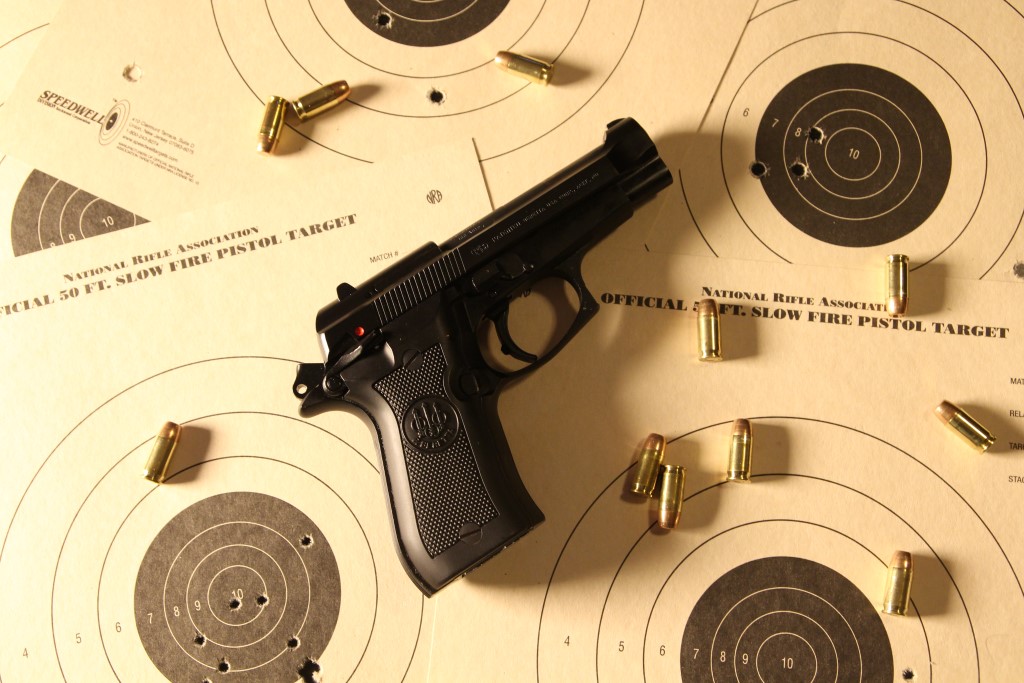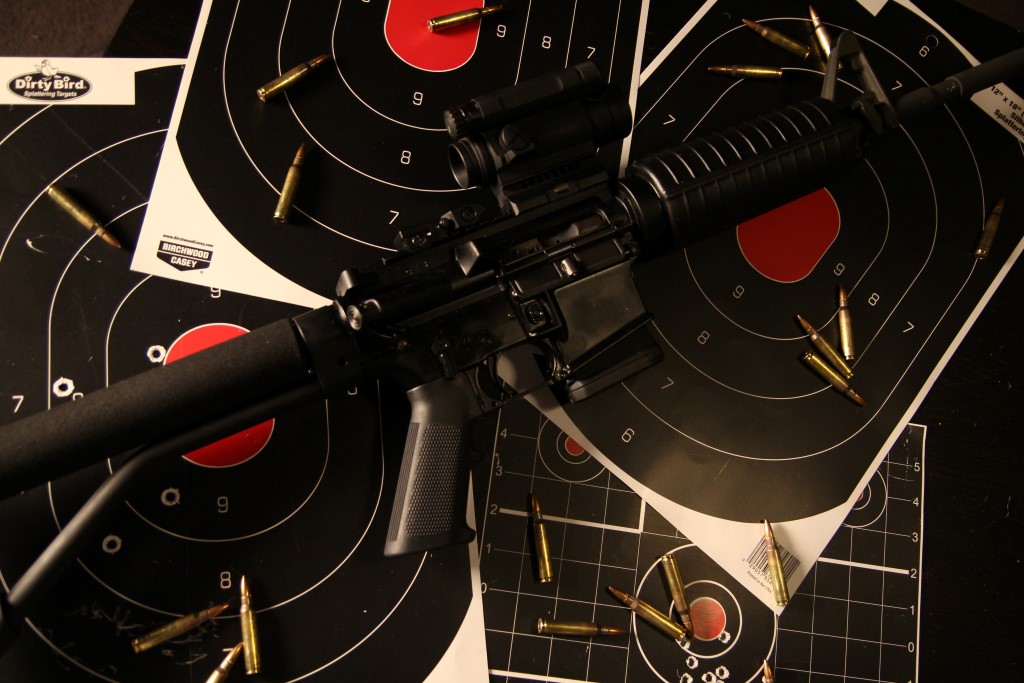What Is a Gun?
A primerMost of us know, basically, what a gun is. If you look up the word in the dictionary, you might find something like, “a weapon incorporating a metal tube from which bullets, shells or other missiles are propelled by explosive force.” Got it.
But what about all those terms you see in the newspaper or on TV that further define these weapons—words like “semi-automatic,” or “high-caliber,” or “12-guage”? What’s the difference between an assault rifle and a machine gun? Mastering such terms is essential for following the national debate on gun control, which is why NY CityLens built this primer on the basic types of guns and the terminology that sets them apart.
How does a gun work?
Guns come in all shapes and sizes, and there are a wide range of firing mechanisms for different guns. It might be more helpful to start with how bullets—the small, pointy pieces of metal that tear into flesh and other targets—work, because they all generally work the same way.
Like fireworks, bullets rely on a smaller fuse to ignite a larger explosion. That explosion propels the bullet out the gun’s barrel and through the air. Besides the gun, there are four ingredients necessary to make the explosion, and they’re all held together in a cartridge (also called a round or a shell).
At the back of the cartridge is the primer, that’s like the fuse on a firework. If you pick up a loaded gun and pull the trigger, the gun’s metal firing pin will strike the primer and start a small flame at the back of the cartridge. That flame then spreads to the second part of the cartridge; the propellant. Propellants are highly explosive gunpowder. When the flame from the primer ignites the propellant, it causes a loud explosion that propels the bullet off its perch atop the cartridge and out the gun at a very high speed. The fourth part, the bullet case (also called a shell casing), is then ejected out the side of the gun.
All of this happens the instant one pulls the trigger. Some guns used by the military can fire up to 100 rounds per second, but not all, which brings us to our next section.

Firing Modes: Semi-automatic? Automatic? Burst?
To get more specific, “gun” is an umbrella term for anything that shoots a projectile, including the massive howitzers that fire artillery shells 20 miles. But a “firearm” is a rifle, pistol or any other kind of smaller, handheld gun. This primer deals with firearms, which are more accessible to the public than tripod-mounted heavy machine guns or anti-tank rocket launchers. Most modern firearms fall under four different firing modes: semi-automatic, automatic, burst, and single shot.
Semi-automatic firearms fire one shot every time the trigger is pulled: bam-bam-bam-bam. Automatic firearms fire continually until the trigger is released: bambambambam. Burst fires multiple shots (usually two to three) every time the trigger is pulled: bambam-bambam. Finally, there are a range of single-shot weapons which require the user to cock, load, pump, or somehow feed the gun a new cartridge by hand every time they fire: bam. A few of these loading mechanisms are lever-action, breech-loading, pump-action, and bolt-action. Some hunters even use revamped versions of muzzle-loading rifles—the sort of gun Revolutionary War soldiers used to spend nearly half-a-minute reloading as redcoats shot back at them—where the propellant and bullet are dropped down the barrel of the gun. But most modern firearms fall under one of these four firing modes.
Now what are those firearms?
Types of guns: Rifle? Pistol? Shotgun? Revolver?
1) Let’s start small, with pistols. A pistol is defined as “a small firearm designed to be held in one hand.” But, as with the word “gun,” there are many variations. A revolver, for example, fires cartridges out of five or six revolving chambers (the part of the firearm where the cartridge is inserted prior to firing). On a revolver, the chambers are arranged to look like a wheel—and they revolve like one too, though the correct term for it is a cylinder. Revolvers are the “six-shooters” you see fired by cowboys in Westerns, or the Smith & Wesson Model 29 used by Harry Callahan in Dirty Harry.

2) Semi-automatic pistols fire from a small box of bullets, called a magazine. A magazine has a spring at the bottom which pushes bullets up into the chamber of a semi-automatic firearm. In a nutshell, semi-automatic weapons rely on the recoil of a shot to clear the spent cartridge and slide a new one into place. The gun fires, the slide (the very top part of a semi-auto pistol) springs back from the recoil, then slides forward with a new round from the magazine in place. But if the cartridge is faulty, or if the magazine is worn out, then the spent cartridge will get stuck in the chamber and must be cleared out manually, which could take too much time in a life-threatening situation. Revolvers, meanwhile, spin a new chamber and a new cartridge into place every time the trigger is pulled, so they don’t misfire as easily. Semi-automatics do have larger magazines than revolvers, though, so they get more shots before needing to re-load. A well-trained semi-auto shooter can better mitigate the risk of misfiring by maintaining the pistol regularly and holding it properly so the slide has the proper resistance (with two hands; trigger hand high up on the grip, palm of support hand against the fingernails of trigger hand, thumb of support hand above the trigger. Trigger hand pushes on the gun a little while support hand pulls back.).
3) A quick note to enhance your understanding: magazines are frequently miscalled “clips,” which are actually just small bits of metal that keep bullets together for the purpose of efficient loading (revolvers, for example, can use a six-round clip to make reloading the cylinder easier). Journalists wouldn’t call one of their own magazines a “clip,” just as they wouldn’t call a portfolio a magazine. If you don’t want to look foolish in front of gun users, don’t say clip when you mean to say magazine.
4) Now onto rifles, which basically work the same way as semi-automatic pistols but with larger bullets and longer barrels. Rifles fire farther and are more powerful than pistols and require two hands to use. A key feature of rifles is that the interior of their barrels are “rifled,” meaning they have spiral-patterned grooves that give a bullet spin and better accuracy over long distances. Carbines are shorter, lighter versions of rifles, and can be useful for soldiers maneuvering in close quarters.

5) “Assault weapon” is a vague term that doesn’t refer specifically to anything. Assault rifles refer specifically to rifles that can fire on semi-automatic and automatic or burst fire modes. Anti-gun groups think assault rifles should be banned from public use because they can spray bullets into a crowd at a much faster rate than semi-automatic-only weapons. Semi-automatic-only rifles can look a lot like assault rifles. Take for instance, the semi-auto AR-15 (pictured above) and the auto-capable M4, one of the military’s most widely-used weapons. Sights and barrels can be interchanged on either weapon to make them look even more similar.
6) Machine guns, are like rifles, only much larger and they only fire on automatic. These weapons are designed specifically for sustained, automatic firing, and are typically fed by long belts of cartridges linked together. Machine guns usually must be mounted on a bipod or tripod to be stable and accurate. On the opposite end of the automatic spectrum, submachine guns are basically automatic pistols, used to rapidly fire a large amount of bullets at close range. Many journalists confuse assault rifles with machine guns and submachine guns, but generally submachine guns are small and magazine-fed, machine guns are huge and belt-fed, and assault rifles are in between and magazine-fed. Even with these guiding principles it can be hard to distinguish between the three, especially, for example, if you are simply observing armed people who are not actively firing their weapons. There is no firm line and the difference between types of guns can be one of degree. Sometimes it just takes practice looking at pictures of different guns to tell them apart. Below is one picture of some very common firearms and a guide for different characteristics to look out for to tell them apart.

GUN GUIDE Light Machine Guns like the American-made M60, the M249, and the Russian-made RPK are usually fed by a belt of ammunition and have a bipod at the front, which machine guns need to rest on in order to shoot accurately at such a high rate of fire. Assault rifles like the AK47, the M16 and the M4 carbine usually have long, slender barrels—for firing at long range—and wide, box-like magazines, which fit large bullets. Submachine guns like the MP5 generally have a shorter barrel—for firing at close-range—and a slender, box-like magazine, designed to fit smaller, pistol-caliber bullets. Submachine guns typically load their magazines in front of the trigger, though there are submachine guns (and assault rifles) which load their magazines behind the grip, in a layout called “bullpup.” Semi-auto pistols load their magazines through the grip. Shotguns generally look like long simple tubes without magazines protruding from it. One key characteristic is the long barrel with a fatter part towards the end. That fat part is called the forend, and the user pumps it back to load a new cartridge into the chamber after firing.
7) Finally, shotguns. Shotguns work like any other gun, but instead of firing a single bullet they fire a handful of tiny pellets, called shot. Some shotguns also fire one large metal bullet, called a slug. Hunters use shot because of their short range, which is a safety advantage in case they miss their target in areas with lots of people hunting. The pellets are also good for taking down small moving targets, such as pheasants in mid-flight. Some police and military personnel like shotguns because of their devastating power at short range. While there are automatic shotguns, the more reliable ones are single-shot, requiring the user to pump a new round into the chamber every time they fire (pump-action), or break the chamber open and slide new rounds in by hand like a revolver.
Fun fact: the “safety” of a firearm is a mechanism that, when active, prevents the firearm from firing. Usually the safety prevents the trigger or the firing pin from moving, or it disconnects the trigger from the firing pin. But even when the safety is off, many experienced gun owners keep their finger off the trigger to prevent accidental firing.

Calibers and Gauge: How are bullets measured?
1) There’s an English and a Metric way of measurement for bullets. Caliber measures the diameter of a bullet—and the barrel of the gun that fires it—in hundredths or sometimes thousandths of an inch. A famous example is the Colt .45, the American semi-automatic pistol that has been in use since 1911. The barrel of the Colt .45 is 45 hundredths of an inch wide, and it fires a .45 ACP (Automatic Colt Pistol) round that is also 45 hundredths of an inch wide. In the metric system, .45 caliber is equivalent to 11.43 mm. Another famous type of ammunition is the 7.62 mm (.30 caliber) bullet fired by AK-47s, the cheap Russian assault rifle used by insurgents and guerrillas around the world. The 7.62 mm bullet is a heavy, slow-moving round whereas the 5.56 mm (.22 caliber) bullet—typically used in Western European, American, and Israeli assault rifles such as the L85, the G36, the FAMAS, the M16 and the Tavor—is lighter and faster, but has less stopping power than the 7.62. When the U.S. supplies weapons to foreign fighters in proxy wars, you’ll typically see those fighters using American-made M16s or M4s, which fire 5.56mm rounds. When the Russians supplies weapons, you’ll typically see fighters using the Russian-made AK-47.
2) Gauge is a tricky measurement, used to indirectly measure the diameter of a shotgun barrel. The gauge refers to the number of lead balls with the shotgun barrel’s diameter that would be required to make up one pound of lead balls. For example, a 12-guage shotgun has a barrel diameter such that 12 lead balls of that diameter would together weigh one pound. A 10 gauge-shotgun would require only ten lead balls of that shotgun barrel’s diameter to weigh one pound. Therefore, the 10-guage shotgun is, counter-intuitively, larger than the 12-guage. Most hunting shotguns don’t even fire lead anymore because the metal is an environmental hazard, but the outdated British measurement system has stuck around.
There, now you have a working knowledge of how firearms work, the basic types of firearms out there, and how different firearms are measured against each other. Now you can leap into the national debate, guns blazing.
The Impact
One Shoe At A Time: A Mother Turns Pain Into Purpose
An Unsolved Shooting Baffles a Mom for Two Decades
How Grief and Anger Turned Into Action
Silver Gun: A Robbery in Queens
Shooter: “It’s Either Them or Me”
After a Single Dad is Shot, a Community Reels
